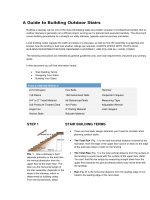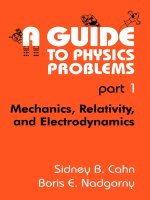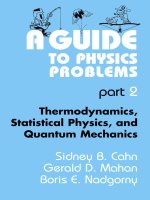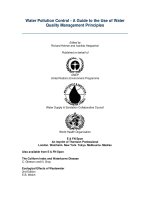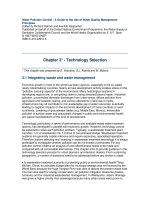A Guide to BS EN 62305:2006 Protection Against Lightning Part 4 pps
Bạn đang xem bản rút gọn của tài liệu. Xem và tải ngay bản đầy đủ của tài liệu tại đây (1.17 MB, 13 trang )
Rolling sphere method
Given the lightning process already described in
Theory of lightning starting on page 4, it is logical
to assume that a lightning strike terminates on the
ground (or on structures) at the point where the
upward streamer was originally launched.
These streamers are launched at points of greatest
electric field intensity (see Figure 4.2a) and can move
in any direction towards the approaching downward
leader. It is for this reason that lightning can strike the
side of tall structures rather than at their highest
point.
BS EN 62305-3 | Rolling sphere method
38
www.furse.com
Figure 4.3: Striking distance (last step)
Figure 4.2b: Development of downward
leader/striking distance
Downward
leader
Vulnerable
points
Vulnerable
points
Less vulnerable
(protected areas)
Striking
distance
(or last step)
Greatest field
intensity
++++
++++
For detail,
see Figure 4.2b
Striking
distance
(or last step)
This hypothesis can be expanded to explain why
corners of structures are vulnerable to lightning
strikes. Figure 4.3 illustrates a sphere rolling over the
surface of the building. The dotted line represents the
path of the centre of the sphere as it is rolled over the
building. The radius of the sphere is the striking
distance, or last step of the lightning discharge.
Thus it can be clearly seen that the corners are
exposed to a quarter of the circular path of the
sphere. This means that if the last step falls within this
part of the circular path it will terminate on the
corner of the building.
The position of the greatest field intensity on the
ground and on structures will be at those points
nearest to the end of the downward leader prior to
the last step. The distance of the last step is termed
the striking distance and is determined by the
amplitude of the lightning current. For example,
points on a structure equidistant from the last step of
the downward leader are equally likely to receive a
lightning strike, whereas points further away are less
likely to be struck (see Figure 4.2b). This striking
distance can be represented by a sphere with a radius
equal to the striking distance.
Figure 4.2a: Development of downward
leader/striking distance
BS EN 62305-3 Physical damage to
structures and life hazard
39
www.furse.com
Rolling sphere method | BS EN 62305-3
The rolling sphere method is used in BS 6651, the
only difference being that in BS EN 62305 there are
different radii of the rolling sphere that correspond
to the relevant Class of LPS (see Table 4.2).
This method is suitable for defining zones of
protection for all types of structures, particularly
those of complex geometry. An example of such an
application is shown in Figure 4.5.
Since the downward leader can approach from any
direction, all possible approach angles can be
simulated by rolling an imaginary sphere all around
and over the structure to be protected, right down to
the ground. Where the sphere touches the structure
lightning protection would be needed. Using the same
logic, the areas where the sphere does not touch the
structure (see shaded area in Figure 4.2b) would be
deemed to be protected and would not require
protection.
The Rolling Sphere method is a simple means of
identifying areas that need protection, taking into
account the possibility of side strikes to the structures.
The basic concept of applying the rolling sphere to a
structure is illustrated in Figure 4.4.
Class of LPS
Rolling sphere radius r
(m)
I 20
II 30
III 45
IV 60
Table 4.2: Maximum values of rolling sphere radius
corresponding to the Class of LPS
Figure 4.4: Application of the rolling sphere method
Rolling
sphere
radius
Air termination
required
Figure 4.5: Application of the rolling sphere method to a
structure of complex geometry
Mast
B
A
Mast
Mast
All yellow areas and the mast should be assessed for
the need for air terminations
View on arrow
A
View on arrow B
Mast
BS EN 62305-3 | Rolling sphere method
40
www.furse.com
Application of protection using the rolling
sphere method
Once the areas of the structure requiring protection
have been identified using the rolling sphere an
air termination network can be designed. The air
termination network can comprise any combination of
the three systems described on page 37, External LPS
design considerations. Reapplying the rolling sphere
can show the effectiveness of the design produced.
Air rods or free standing masts
Air rods or free standing masts can be used to keep
the rolling sphere away from the structure to be
protected. If correctly dimensioned, air rods or free
standing masts will ensure that the sphere does not
come into contact with any part of the structure’s
roof.
If the system must be isolated from the structure then
a free standing mast could be employed. See Figure
4.6. Clearly this arrangement is only suitable for
smaller structures or isolated pieces of equipment.
The separation distance s indicated on Figure 4.6
ensures isolation between the LPS and the structure.
The method of determining the separation distance is
dealt with on page 65, Separation (isolation) distance
of the external LPS.
s
Figure 4.7c: View on arrow B
A
B
Rolling sphere
radius
x
y
xy
BS EN 62305-3 Physical damage to
structures and life hazard
If the system does not need to be isolated from the
structure then air rods fitted to the roof of the
structure could be employed. See Figure 4.7a.
The height of the air rods utilised is now a function of
the rolling sphere radius (Class of LPS) and the spacing
between the air rods.
If the rods are arranged in a square it is the distance
between two diagonally opposite rods (see Figure
4.7c) rather than two adjacent rods (see Figure 4.7b)
that must be considered when determining the
penetration depth of the rolling sphere.
Figure 4.6: Application of the rolling sphere to an isolated
free standing mast
Figure 4.7a: Application of the rolling sphere to air rods in a
non-isolated system
Figure 4.7b: View on arrow A
41
www.furse.com
Catenary (or suspended) conductors | BS EN 62305-3
A
B
Rolling sphere
radius
Catenary (or suspended) conductors
As with a free standing mast, catenary conductors can
be used to keep the rolling sphere away from the
structure to be protected. One or more catenary
conductors may be utilised to ensure that the sphere
does not come into contact with any part of the
structure’s roof.
If the system is required to be isolated from the
structure then a conductor suspended between two
free standing masts may be employed. See Figure 4.8.
This arrangement is suitable for small sensitive
structures such as explosive stores. Once again the
separation distance (s) indicated on Figure 4.8c should
be ensured.
Figure 4.8a: Application of the rolling sphere to catenary
conductors forming an isolated system
In a non isolated system, a catenary conductor may
be used to protect larger items of roof mounted
equipment from a direct strike. See Figure 4.9.
Figure 4.8c: View on arrow B
s
Unlike individual air rods arranged in a square, it is
simply the distance between the two parallel
conductors (see Figure 4.8b and Figure 4.9) that must
be considered when determining the penetration
depth of the rolling sphere.
Figure 4.8b: View on arrow A
BS EN 62305-3 | Catenary (or suspended) conductors
42
www.furse.com
Figure 4.9: Application of the rolling sphere to two parallel catenary conductors in a non-isolated system
h
s
p
Rolling sphere
radius
Catenary conductors
(air termination)
Space protected
by two parallel
catenary conductors
Connection to
air termination
network
Connection to
air termination
network
Reference
plane
Catenary conductors
(air termination)
BS EN 62305-3 Physical damage to
structures and life hazard
h Physical height of catenary conductors above the reference plane
s Separation distance
p Penetration distance of the rolling sphere
43
www.furse.com
Meshed conductor network | BS EN 62305-3
Meshed conductor network
If the rolling sphere principle is used in conjunction
with a meshed conductor network, the mesh must be
mounted at some distance above the roof, to ensure
the rolling sphere does not touch its surface. In a
similar way to the catenary conductors, the
penetration distance of the sphere below the level
of the mesh is determined by the distance between
parallel mesh conductors. See Figure 4.10.
Figure 4.10: Application of the rolling sphere to elevated meshed conductors forming a non-isolated system
A
B
Rolling sphere
radius
View on arrow A
View on arrow B
The protective angle method
The protective angle method is a mathematical
simplification of the rolling sphere method (see
Figure 4.12). The protective angle is derived by initially
rolling a sphere up to a vertical air termination eg an
air rod (AB). A line is then struck from the point where
the sphere touches the air rod (A) down to the
reference plane (D), finishing at point C. The line must
bisect the sphere (circle) such that the areas (shaded)
of over and under estimation of protection (when
compared to the rolling sphere method) are equal.
The angle created between the tip of the vertical rod
(A) and the projected line is termed the protective
angle alpha (α).
The above procedure was applied to each Class of LPS
using its corresponding rolling sphere. The protective
angle afforded by an air rod located on a reference
plane can be determined from Figure 4.11 or
Table 4.3.
BS EN 62305-3 | Protective angle method
44
www.furse.com
Figure 4.11: Determination of the protective angle (BS EN 62305-3 Table 2)
0
0
Note 1 Not applicable beyond the values marked with
Only rolling sphere and mesh methods apply in these cases
Note 2 h is the height of air-termination above the reference plane of the area to be protected
Note 3 The an
g
le will not chan
g
e for values of h below 2m
2 10 20 30
h(m)
I II III
Class of LPS
IV
40 50 60
10
20
30
40
50
60
70
80
˚
Figure 4.12: Derivation of the protective angle
Section through a rolling
sphere of radius r = 30m
See ‘Minimum current
parameters’ on
page 16
A
B
D
C
Protection overestimated
by the simplified protective
angle method
Protection underestimated
by the simplified protective
angle method
BS EN 62305-3 Physical damage to
structures and life hazard
45
www.furse.com
Protective angle method | BS EN 62305-3
Table 4.3: Simple determination of the protective angle
Height of air
rod above
reference plane
(m)
LPS Class IV LPS Class III LPS Class II LPS Class I
Angle
(deg)
Radius
(m)
Angle
(deg)
Radius
(m)
Angle
(deg)
Radius
(m)
Angle
(deg)
Radius
(m)
1 78.7 5.0 76.3 4.0 73.2 3.2 70.0 2.8
2 78.7 10.0 76.3 7.9 73.2 6.4 70.0 5.5
3 76.7 12.6 74.1 10.3 70.1 8.2 66.3 6.8
4 74.7 14.6 72.0 12.2 67.1 9.5 62.6 7.7
5 72.8 16.2 69.9 13.7 64.4 10.6 59.1 8.4
6 71.0 17.5 67.9 15.0 62.0 11.4 55.9 8.9
7 69.3 18.6 66.0 16.0 59.7 12.1 53.0 9.3
8 67.7 19.6 64.3 16.9 57.6 12.7 50.2 9.6
9 66.2 20.4 62.6 17.7 55.6 13.2 47.7 9.9
10 64.7 21.2 61.1 18.3 53.8 13.6 45.2 10.0
11 63.4 22.0 59.6 18.9 52.0 14.0 42.8 10.1
12 62.1 22.6 58.2 19.4 50.3 14.4 40.4 10.2
13 60.8 23.3 56.8 19.9 48.6 14.6 38.1 10.2
14 59.6 23.8 55.4 20.3 47.0 14.9 35.8 10.1
15 58.4 24.4 54.1 20.6 45.4 15.1 33.6 10.0
16 57.3 24.9 52.8 20.9 43.8 15.2 31.4 9.8
17 56.2 25.4 51.5 21.2 42.3 15.3 29.2 9.6
18 55.2 25.9 50.3 21.5 40.6 15.4 27.1 9.3
19 54.2 26.3 49.1 21.7 39.2 15.4 24.9 8.9
20 53.2 26.8 47.9 21.9 37.7 15.4 22.8 8.4
21 52.3 27.2 46.6 22.0 36.3 15.4
22 51.3 27.6 45.5 22.1 34.8 15.3
23 50.5 27.9 44.3 22.2 33.4 15.1
24 49.6 28.3 43.1 22.3 31.9 14.9
25 48.8 28.6 42.0 22.4 30.5 14.7
26 48.0 28.9 40.9 22.4 29.0 14.3
27 47.2 29.1 39.8 22.4 27.5 13.9
28 46.4 29.4 38.7 22.4 25.9 13.4
29 45.6 29.6 37.7 22.3 24.4 12.9
30 44.8 29.8 36.7 22.3 22.8 12.2
31 44.1 30.0 35.7 22.2
32 43.3 30.1 34.7 22.1
33 42.6 30.3 33.7 21.9
34 41.8 30.4 32.8 21.8
35 41.1 30.4 31.8 21.6
36 40.3 30.5 30.9 21.3
37 39.6 30.5 29.9 21.1
38 38.8 30.4 29.0 20.8
39 38.1 30.4 28.1 20.5
40 37.3 30.3 27.2 20.2
41 36.6 30.2 26.2 19.8
42 35.9 30.0 25.3 19.4
43 35.1 29.9 24.4 18.9
44 34.4 29.7 23.5 18.4
45 33.6 29.4 23.5 17.9
46 32.9 29.1
47 32.2 28.8
48 31.5 28.5
49 30.7 28.1
50 30.0 27.7
51 29.3 27.3
52 28.5 26.9
53 27.8 26.4
54 27.1 25.9
55 26.4 25.3
56 25.7 24.8
57 24.9 24.2
58 24.2 23.6
59 23.5 23.0
60 22.8 22.3
Angle (deg)
Height
(m)
Radius (m)
BS EN 62305-3 | Protective angle method
46
www.furse.com
The above concept can be extended to a catenary
conductor. See Figure 4.15. At each end of the
catenary conductor (A) a cone of protection is created
relative to height h. A similar cone is created at every
point along the suspended conductor. It should be
noted that any sag in the suspended conductor would
lead to a reduction in the zone of protection at the
reference plane. This produces an overall ‘dog bone’
shape at the reference plane.
Note 1 in Figure 4.11 identifies the restrictions when
using the protective angle method for the air
termination system design. When the structure/air
rod/mast, relative to the reference plane, is greater in
height than the appropriate rolling sphere radius, the
zone of protection afforded by the protection angle is
no longer valid (see Figure 4.13).
For example if the design was to a structural LPS Class
II, and the structure’s height was 50m, then using the
appropriate rolling sphere of 30m radius would leave
the upper 20m needing lightning protection. If an air
rod or a conductor on the edge of the roof was
installed then a zone of protection angle could not be
claimed because the rolling sphere had already
identified that the upper 20m was not protected.
Thus the protective angle method is only valid up to
the height of the appropriate rolling sphere radius.
The protective angle afforded by an air rod is clearly a
three dimensional concept. See Figure 4.14. Therefore
a simple air rod is assigned a cone of protection by
sweeping the line AC at the angle of protection a full
360º around the air rod.
Figure 4.13: Limitation of the use of the protective
angle method
h = 50m
Protection overestimated
by the simplified protective
angle method
Section through a rolling
sphere of radius r = 30m.
See ‘Minimum current
parameters’ on page 16
Tip of air termination
Reference
plane
Protective
angle
Radius of
protected area
Height of an air
termination rod
above the reference
plane of the area
to be protected
h
A
C
Figure 4.14: The protective angle method for a single air rod
Tip of air termination
Reference
plane
Protective
angle
Radius of
protected area
Height of an air
termination rod
above the reference
plane of the area
to be protected
A
A
h
h
C
C
Figure 4.15: The protective angle method for a catenary
conductor
BS EN 62305-3 Physical damage to
structures and life hazard
Varying the protection angle is a change to the simple
45º zone of protection afforded in most cases in
BS 6651. Furthermore this standard uses the height of
the air termination system above the reference plane,
whether that be ground or roof level. See Figure 4.16.
The protective angle method is suitable for simple
shaped buildings.
47
www.furse.com
Protective angle method | BS EN 62305-3
h
h
2
h
1
2
1
Figure 4.16: Effect of the height of the reference plane on
the protection angle
Air rods or free standing masts
The effectiveness of an isolated free standing mast
used to protect a small object can be proven by the
protection angle method. See Figure 4.17.
s
Figure 4.17: Application of the protection angle to an
isolated free standing mast
Figure 4.18a: Application of the protection angle method to
air rods in a non-isolated system
Application of protection using the protective
angle method
Unlike the rolling sphere, the protective angle method
is not used to determine which parts of a structure
require protection. It is however used in a similar way
to the rolling sphere to show the effectiveness of the
designed protection system.
Once again if the system does not need to be isolated
from the structure then air rods fitted to the roof of
the structure could be employed. See Figure 4.18a.
The height of the air rods utilised is now a function
of the protection angle (Class of LPS), the spacing
between the air rods and the height above a
particular reference plane. See Figure 4.18b.
21
Figure 4.18b: View on arrow A
BS EN 62305-3 | Catenary (or suspended) conductors
48
www.furse.com
Figure 4.19: Application of the protection angle method to an air rod in a non-isolated system
Connection to
air termination
network
Reference plane
Space protected by
vertical air rod
Vertical air rod
(air termination)
h
s
BS EN 62305-3 Physical damage to
structures and life hazard
In a non-isolated system, an air rod (or multiple air rods) may be used to protect larger items of roof mounted
equipment from a direct strike. See Figure 4.19.
h Physical height of air rod above the reference plane
α Protective angle (alpha)
s Separation distance
49
www.furse.com
Catenary (or suspended) conductors
One or more catenary conductors may be utilised to
provide a zone of protection over an entire structure.
See Figure 4.20.
Meshed conductor network
As with the rolling sphere method a meshed
conductor network must be mounted at some distance
above the roof. This is in order to provide an effective
zone of protection using the protective angle method.
See Figure 4.21.
Meshed conductor network | BS EN 62305-3
Protection at maximum
conductor sag
s
View on arrow A
1
2
Figure 4.20c: View on arrow B
Figure 4.20b: View on arrow A
Figure 4.20a: Application of the protection angle method to
catenary conductors forming an isolated system
Figure 4.21: Application of the protection angle method to
elevated meshed conductors forming a non-isolated system
BS EN 62305-3 | Mesh method
50
www.furse.com
The mesh method
This is the method that is most commonly used in
BS 6651. Again, four different air termination mesh
sizes are defined and correspond to the relevant Class
of LPS (see Table 4.4 ).
Class of LPS Mesh size W
(m)
I 5 x 5
II 10 x 10
III 15 x 15
IV 20 x 20
This method is suitable where plain surfaces require
protection if the following conditions are met:
● Air termination conductors must be positioned at
roof edges, on roof overhangs and on the ridges
of roofs with a pitch in excess of 1 in 10 (5.7º)
● No metal installation protrudes above the air
termination system
As in BS 6651, this standard permits the use of
conductors (whether they be fortuitous metalwork or
dedicated LP conductors) under the roof. Vertical air
rods (finials) or strike plates should be mounted above
the roof and connected to the conductor system
beneath. The air rods should be spaced not more
than 10m apart and if strike plates are used as an
alternative, these should be strategically placed over
the roof area not more than 5m apart.
As modern research on lightning inflicted damage has
shown, the edges and corners of the roofs are most
susceptible to damage.
So on all structures particularly with flat roofs, the
perimeter conductors should be installed as close to
the outer edges of the roof as is practicable.
Non-conventional air termination systems
A lot of technical (and commercial) debate has raged
over the years regarding the validity of the claims
made by the proponents of such systems. This topic
was discussed extensively within the technical working
groups that compiled this standard. The outcome was
to remain with the information housed within this
standard. Typically, Annex A (normative) which discuss
the positioning of the air rods (finials) states
unequivocally that the volume or zone of protection
afforded by the air termination system (eg air rod)
shall be determined only by the real physical
dimension of the air termination system. Typically
if the air rod is 5m tall then the only claim for the
zone of protection afforded by this air rod would be
based on 5m and the relevant Class of LPS and not any
enhanced dimension claimed by some
non-conventional air rods.
It is important to note that this British Standard will
remain in force until at least 2010, prior to this time
the technical committee maintenance teams that
compiled this standard will review and refine the
body of this standard based on any further technical
information and research that becomes available.
There is no other standard being contemplated to run
in parallel with this standard.
Table 4.4: Maximum values of mesh size corresponding to
the Class of LPS
Figure 4.22: Concealed air termination network
Vertical air
termination
or strike plate
Horizontal
conductor
Cross section of roof ridge
Roof pitch
BS EN 62305-3 Physical damage to
structures and life hazard
Concealed
conductor
Vertical air
termination
Down conductor

